ECO mode Citroen DS5 2016 1.G Owner's Manual
[x] Cancel search | Manufacturer: CITROEN, Model Year: 2016, Model line: DS5, Model: Citroen DS5 2016 1.GPages: 500, PDF Size: 55.11 MB
Page 6 of 500
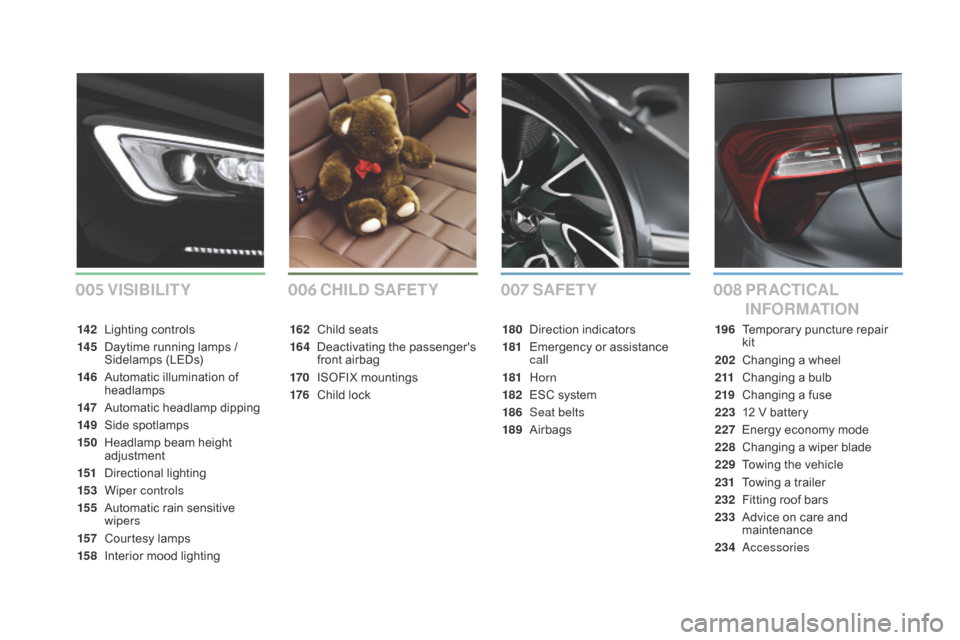
005006007008
DS5_en_Chap00a_sommaire_ed02-2015
SAFETY PR AcTIcAL
INFORMATIONcH
ILd SA
FETYvISI
BILITY
142 Lighting controls
14 5
Da
ytime running lamps /
Sidelamps (LEDs)
14 6
Au
tomatic illumination of
headlamps
147
Au
tomatic headlamp dipping
14 9
Si
de spotlamps
15 0
He
adlamp beam height
adjustment
151
Dir
ectional lighting
153
Wi
per controls
155
Au
tomatic rain sensitive
wipers
157
Co
urtesy lamps
15 8
In
terior mood lighting 162 Ch
ild seats
164
Dea
ctivating the passenger's
front airbag
170
IS
OFIX mountings
176
Ch
ild lock180 Di
rection indicators
181
Em
ergency or assistance
call
181
Hor
n
182
ESC s
ystem
186
Sea
t belts
189
Air
bags196 Te
mporary puncture repair
kit
202
Ch
anging a wheel
2 11
Chan
ging a bulb
219
Chan
ging a fuse
223
12 V b
attery
227
En
ergy economy mode
228
Ch
anging a wiper blade
229
To
wing the vehicle
231
To
wing a trailer
232
Fi
tting roof bars
233
Ad
vice on care and
maintenance
234
A
ccessories
Page 15 of 500

13
DS5_en_Chap00b_vue-ensemble_ed02-2015
Maintenance - Technical data
Checking levels 247-250
- oi l
-
br
ake fluid
-
po
wer steering fluid
-
co
olant
-
sc
reenwash/headlamp wash fluid
AdBlue additive
25
3 -261
Checking components
25
1-252
-
ai
r filter
-
pa
ssenger compartment filter
-
oi
l filter
-
el
ectric parking brake
-
br
ake pads / discs
Changing bulbs
21
1-218
-
fr
ont
-
re
ar Opening the bonnet
24
3
Under the bonnet, petrol
24
4
Under the bonnet, Diesel
24
5Dimensions
27
3
Identification markings
27
4
Running out of fuel (Diesel)
24
6
12V battery
22
3 -226
Load reduction, economy mode
22
7
Engine compartment
fuses
21
9 -220, 222
Petrol engines
26
4
Diesel engines
267
-268
Petrol weights 26 5 -266
Diesel weights
26
9 -272
Over view
Page 16 of 500

DS5_en_Chap00c_eco-conduite_ed02-2015
Eco-driving
Eco-driving is a range of everyday practices that allow the motorist to optimise their fuel consumption and CO2 emissions.
Optimise the use of your gearbox
With a manual gearbox, move off gently and change up without waiting.
During acceleration change up early.
With an automatic gearbox, give preference to automatic mode and
avoid pressing the accelerator pedal heavily or suddenly.
The gear efficiency indicator invites you engage the most suitable gear:
as soon as the indication is displayed in the instrument panel, follow it
straight away.
For vehicles fitted with an automatic gearbox, this indicator appears
only in manual mode.
drive smoothly
Maintain a safe distance between vehicles, use engine braking rather
than the brake pedal, and press the accelerator progressively. These
practices contribute towards a reduction in fuel consumption and CO
2
emissions and also helps reduce the background traffic noise.
If your vehicle has cruise control, make use of the system at speeds
above 25 mph (40 km/h) when the traffic is flowing well.
control the use of your electrical
e quipment
Before moving off, if the passenger compartment is too warm, ventilate it
by opening the windows and air vents before using the air conditioning.
Above 30 mph (50 km/h), close the windows and leave the air vents
open.
Remember to make use of equipment that can help keep the
temperature in the passenger compartment down (sunroof and window
blinds...).
Switch off the air conditioning, unless it has automatic regulation, as
soon as the desired temperature is attained.
Switch off the demisting and defrosting controls, if not automatic.
Switch off the heated seat as soon as possible.
Switch off the headlamps and front foglamps when the level of light
does not require their use.
Avoid running the engine before moving off, particularly in winter; your
vehicle will warm up much faster while driving.
As a passenger, if you avoid connecting your multimedia devices
(film, music, video game...), you will contribute towards limiting the
consumption of electrical energy, and so of fuel.
Disconnect your portable devices before leaving the vehicle.
Page 21 of 500

19
Indicator and warning lamps
When the engine is started, these same
warning lamps should go off.
If they remain on, before moving off, refer to the
information on the warning lamp concerned.
Associated warnings
The switching on of certain warning lamps may
be accompanied by an audible signal and a
message in the instrument panel screen.
The warning lamps may come on continuously
(fixed) or flash.Certain warning lamps may come on in
one of two modes: fixed (continuous) or
flashing.
Only by relating the type of illumination
to the operation of the vehicle can it
be determined whether the situation is
normal or a fault has occurred.
Refer to the tables on the following
pages for more information.
Visual indicators informing the driver that a
system is in operation, switched off or has a
fault.
When the ignition is switched on
Certain warning lamps come on for a few
seconds in the instrument panel and/or
instrument panel screen when the vehicle's
ignition is switched on.
Monitoring
Page 24 of 500
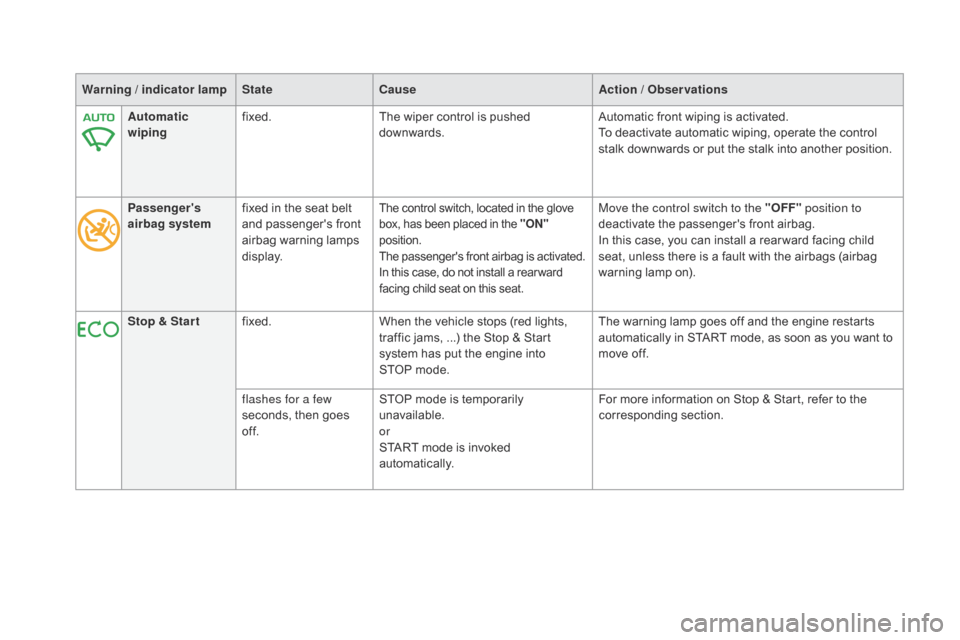
Warning / indicator lampStatecause A ction / Observations
Automatic
wiping fixed.
The wiper control is pushed
downwards. Automatic front wiping is activated.
To deactivate automatic wiping, operate the control
stalk downwards or put the stalk into another position.
Passenger's
airbag system fixed in the seat belt
and passenger's front
airbag warning lamps
display.
The control switch, located in the glove
box, has been placed in the "ON"
position.
The passenger's front airbag is activated.
In this case, do not install a rear ward
facing child seat on this seat.Move the control switch to the "OFF" position to
deactivate the passenger's front airbag.
In this case, you can install a rear ward facing child
seat, unless there is a fault with the airbags (airbag
warning lamp on).
Stop & Star t fixed. When the vehicle stops (red lights,
traffic jams,
.
..) the Stop & Start
system has put the engine into
STOP
m
ode. The warning lamp goes off and the engine restarts
automatically in START mode, as soon as you want to
move off.
flashes for a few
seconds, then goes
of f. STOP mode is temporarily
unavailable.
or
START mode is invoked
automatically. For more information on Stop & Start, refer to the
corresponding section.
Page 68 of 500

DS5_en_Chap02_ouvertures_ed02-2015
Electric windows
1. Left hand front electric window switch.
2. Ri ght hand front electric window
switch.
3.
Ri
ght hand rear electric window switch.
Operation
Manual mode
To open or close the window, press or pull the
switch gently. The window stops as soon as the
switch is released.
4.
Lef
t hand rear electric window switch.
5.
dea
ctivating the rear electric window
switches,
loc
king the rear doors
(c
hild lock).
Automatic mode
To open or close the window, press or pull
switch fully: the window opens or closes
completely when the switch is released.
Pressing or pulling the switch again stops the
movement of the window. The electric window switches
remain operational for approximately
45
s
econds after switching off the
ignition, while the vehicle's doors are
still closed.
Once a door is opened, or once the
45 seconds have elapsed, you have
to switch on the ignition to operate the
windows.
Page 75 of 500
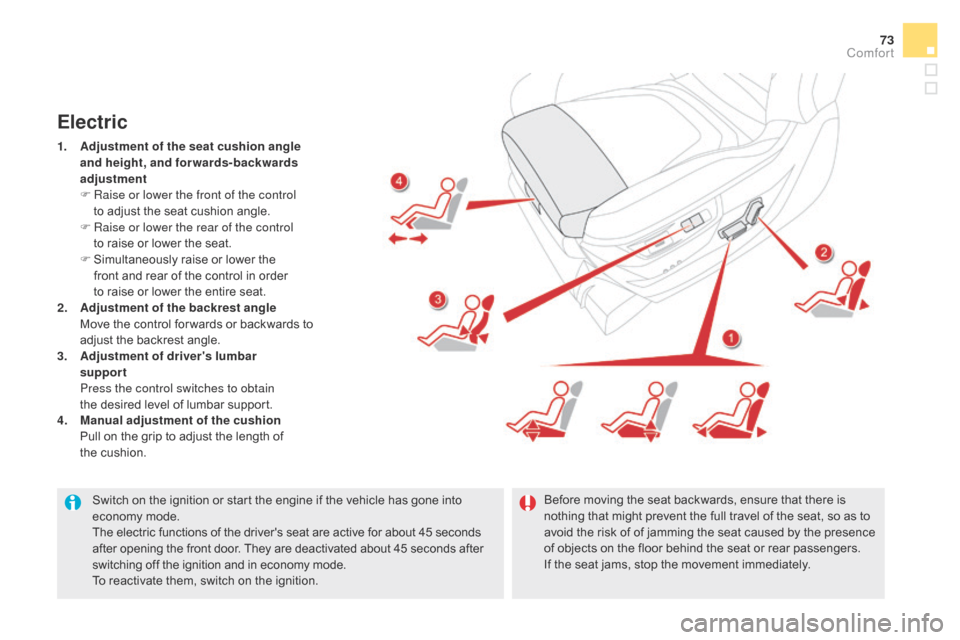
73
DS5_en_Chap03_confort_ed02-2015
Switch on the ignition or start the engine if the vehicle has gone into
economy mode.
The electric functions of the driver's seat are active for about 45 seconds
after opening the front door. They are deactivated about 45 seconds after
switching off the ignition and in economy mode.
To reactivate them, switch on the ignition.
Electric
1. Adjustment of the seat cushion angle
and height, and forwards-backwards
adjustment
F
Ra
ise or lower the front of the control
to
a
djust the seat cushion angle.
F
Ra
ise or lower the rear of the control
to
r
aise or lower the seat.
F
Si
multaneously raise or lower the
front
a
nd rear of the control in order
to
r
aise or lower the entire seat.
2.
Ad
justment of the backrest angle
Mov
e the control for wards or backwards to
adjust the backrest angle.
3.
Ad
justment of driver's lumbar
support
Pr
ess the control switches to obtain
the
d
esired level of lumbar support.
4.
Ma
nual adjustment of the cushion
Pu
ll on the grip to adjust the length of
the
c
ushion. Before moving the seat backwards, ensure that there is
nothing that might prevent the full travel of the seat, so as to
avoid the risk of of jamming the seat caused by the presence
of objects on the floor behind the seat or rear passengers.
If
t
he seat jams, stop the movement immediately.
comfort
Page 92 of 500

DS5_en_Chap03_confort_ed02-2015
In order for these systems to be fully effective, follow the operation and maintenance
guidelines below:
F
To o
btain an even air distribution, take care not to obstruct the exterior air intake grilles
located at the base of the windscreen, the nozzles, the vents and the air outlets, as well
as the air extractor located in the boot.
F
Do n
ot cover the sunshine sensor, located on the dashboard; this is used for regulation
of the digital air conditioning system.
F
Op
erate the air conditioning system for at least 5 to 10 minutes, once or twice a month
to keep it in per fect working order.
F
En
sure that the passenger compartment filter is in good condition and have the filter
elements replaced regularly (refer to the "Checks" section).
We r
ecommend the use of a combined passenger compartment filter. Thanks to its
special active additive, it contributes to the purification of the air breathed by the
occupants and the cleanliness of the passenger compartment (reduction of allergic
symptoms, bad odours and greasy deposits).
F
To e
nsure correct operation of the air conditioning system, you are also advised to have
it checked regularly as recommended in the maintenance and warranty guide.
F
If t
he system does not produce cold air, switch it off and contact a CITROËN dealer or a
qualified workshop.
You can switch off the air conditioning (AC button) and stay in Automatic mode in order
to limit fuel consumption. If misting appears while in this mode, you can switch the air
conditioning back on temporarily to improve the situation.
When towing the maximum load on a steep gradient in high temperatures, switching off the
air conditioning increases the available engine power and so improves the towing ability.
Recommendations for ventilation and air conditioning
If after an extended stop in sunshine,
the interior temperature is very high, first
ventilate the passenger compartment for
a few moments.
Put the air flow control at a setting high
enough to quickly change the air in the
passenger compartment.
The air conditioning system does not
contain chlorine and does not present
any danger to the ozone layer.
The condensation created by the air
conditioning results in a discharge
of water under the vehicle which is
per fectly normal.
If you want to prioritise heating, start
and leave the engine running by
pressing ECO OFF.
Page 93 of 500
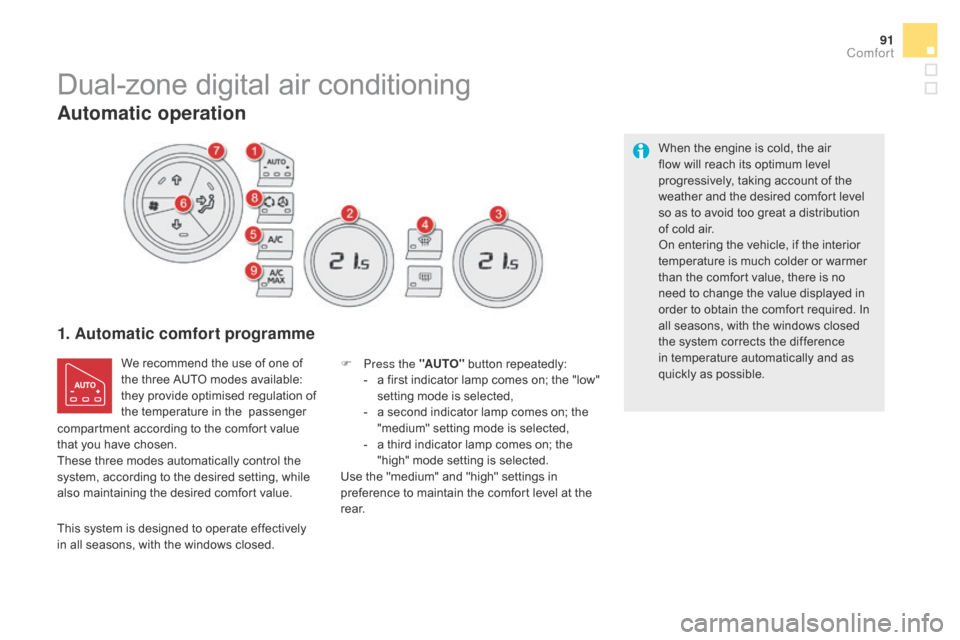
91
DS5_en_Chap03_confort_ed02-2015
Dual-zone digital air conditioning
1. Automatic comfort programme
We recommend the use of one of
the three AUTO modes available:
they provide optimised regulation of
the temperature in the
p
assenger F Pr
ess the "AUTO" button repeatedly:
-
a fi
rst indicator lamp comes on; the "low"
setting mode is selected,
-
a se
cond indicator lamp comes on; the
"medium" setting mode is selected,
-
a th
ird indicator lamp comes on; the
"high" mode setting is selected.
Use the "medium" and "high" settings in
preference to maintain the comfort level at the
r e a r. When the engine is cold, the air
flow will reach its optimum level
progressively, taking account of the
weather and the desired comfort level
so as to avoid too great a distribution
of cold air.
On entering the vehicle, if the interior
temperature is much colder or warmer
than the comfort value, there is no
need to change the value displayed in
order to obtain the comfort required. In
all seasons, with the windows closed
the system corrects the difference
in temperature automatically and as
quickly as possible.
This system is designed to operate effectively
in all seasons, with the windows closed.
Automatic operation
compartment according to the comfort value
that you have chosen.
These three modes automatically control the
system, according to the desired setting, while
also maintaining the desired comfort value.
comfort
Page 103 of 500
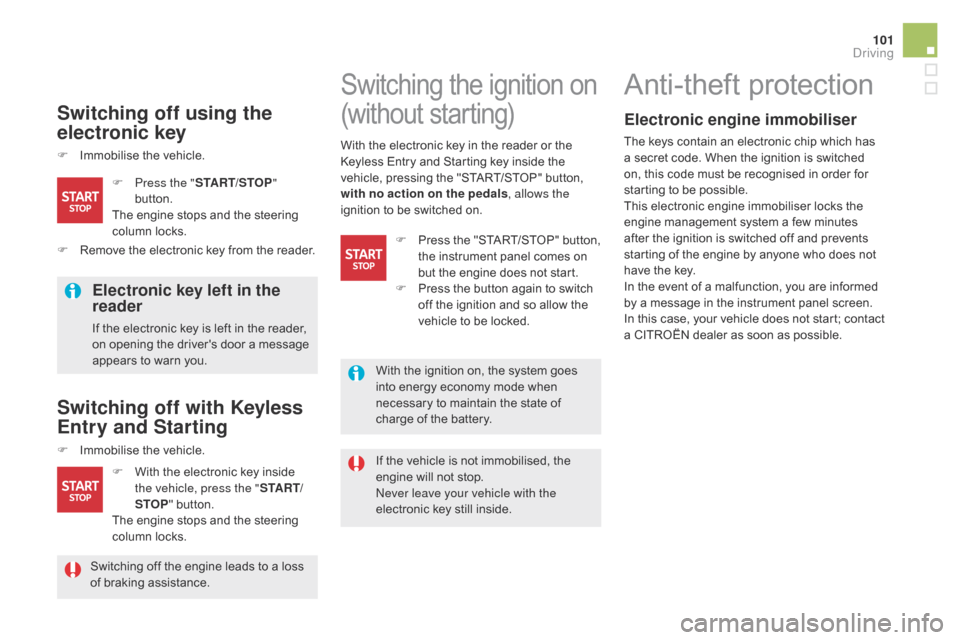
101
DS5_en_Chap04_conduite_ed02-2015
Switching off using the
electronic key
F Immobilise the vehicle.
Electronic key left in the
reader
If the electronic key is left in the reader,
on opening the driver's door a message
appears to warn you.
Switching off with Keyless
Entry and Starting
F Immobilise the vehicle.I f the vehicle is not immobilised, the
engine will not stop.
Never leave your vehicle with the
electronic key still inside.
Switching the ignition on
(without starting)
F With the electronic key inside
t he vehicle, press the " S TA R T/
STOP " button.
The engine stops and the steering
column locks. F
Pr
ess the "
START/STOP "
button.
The engine stops and the steering
column locks.
Anti-theft protection
Electronic engine immobiliser
The keys contain an electronic chip which has
a secret code. When the ignition is switched
on, this code must be recognised in order for
starting to be possible.
This electronic engine immobiliser locks the
engine management system a few minutes
after the ignition is switched off and prevents
starting of the engine by anyone who does not
have the key.
In the event of a malfunction, you are informed
by a message in the instrument panel screen.
In this case, your vehicle does not start; contact
a CITROËN dealer as soon as possible.
With the electronic key in the reader or the
Keyless Entry and Starting key inside the
vehicle, pressing the "START/STOP" button,
with no action on the pedals
, allows the
ignition to be switched on.
F
Re
move the electronic key from the reader. F
Pr
ess the "START/STOP" button,
the instrument panel comes on
but the engine does not start.
F
Pr
ess the button again to switch
off the ignition and so allow the
vehicle to be locked.
With the ignition on, the system goes
into energy economy mode when
necessary to maintain the state of
charge of the battery.
Switching off the engine leads to a loss
of braking assistance.
driving